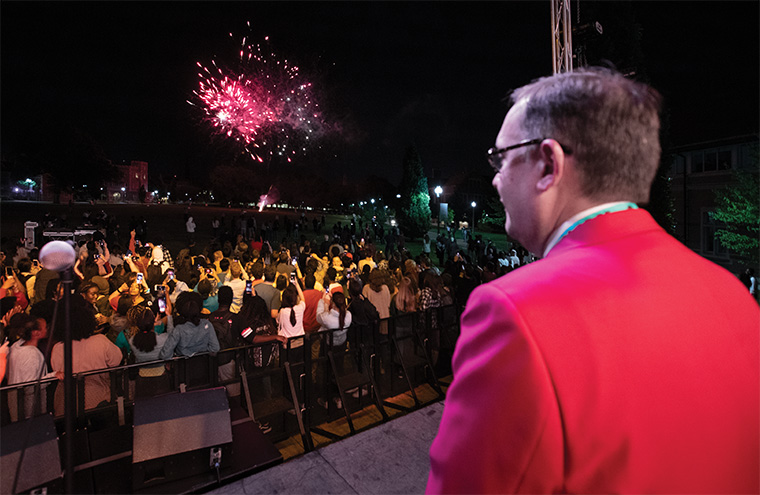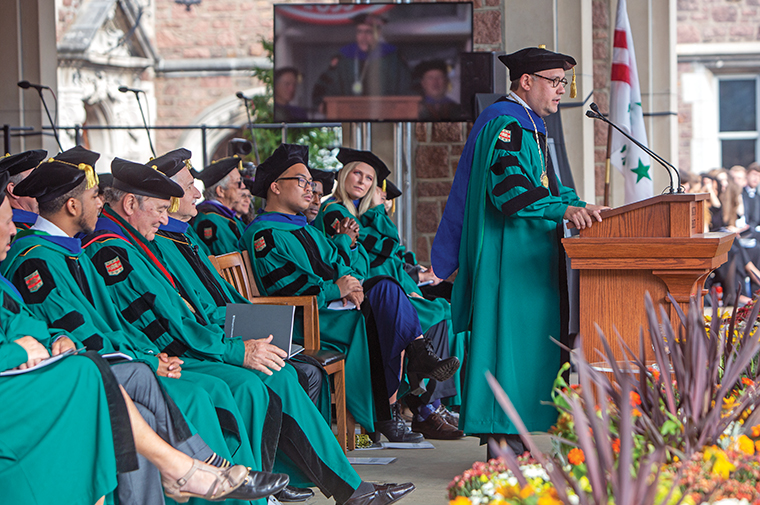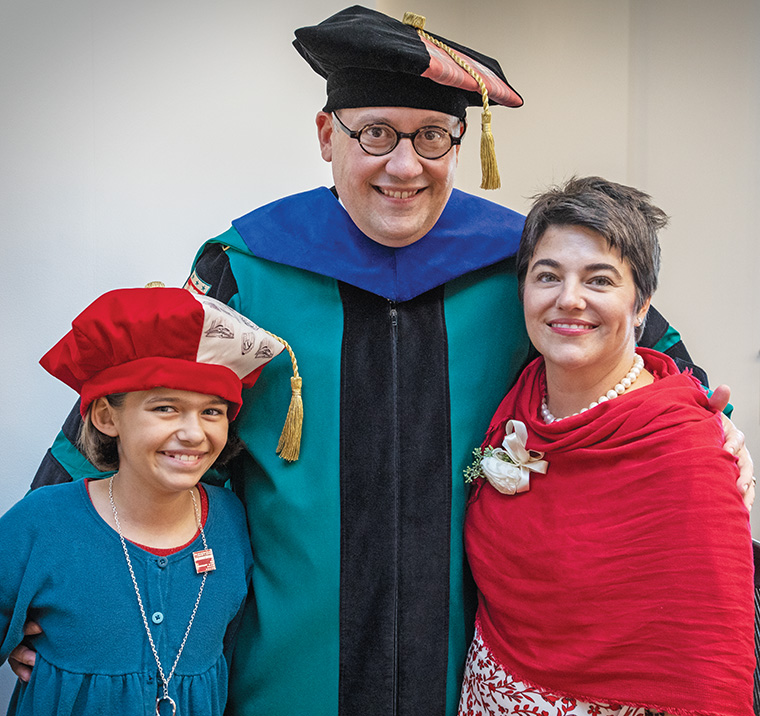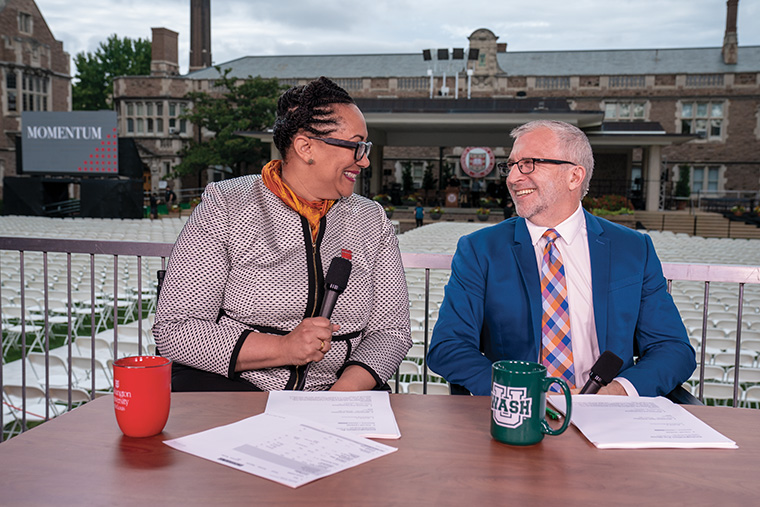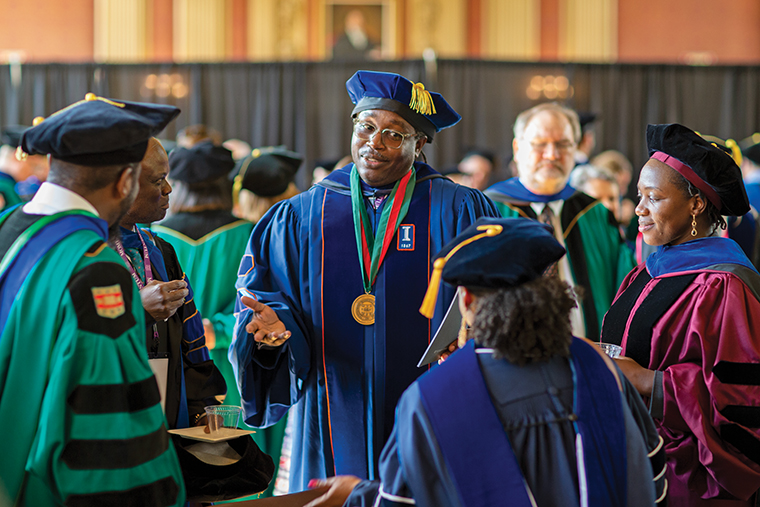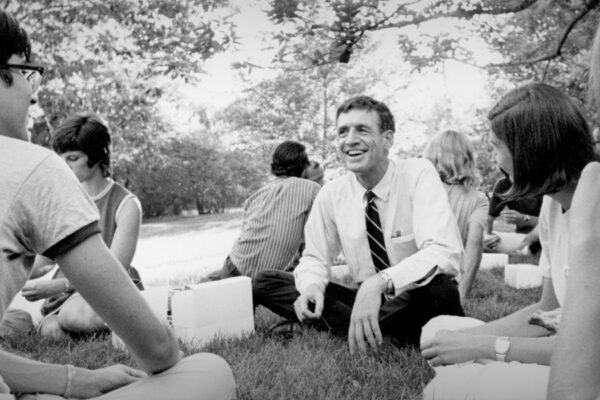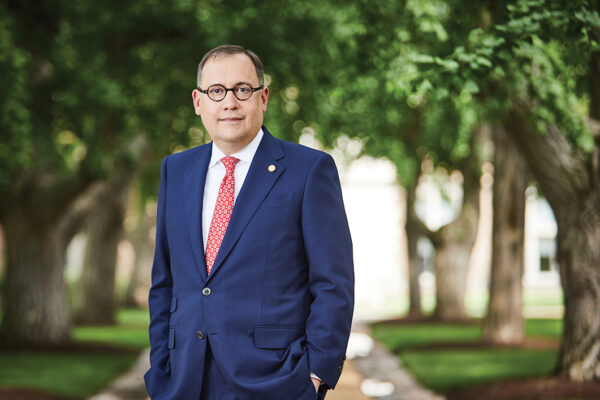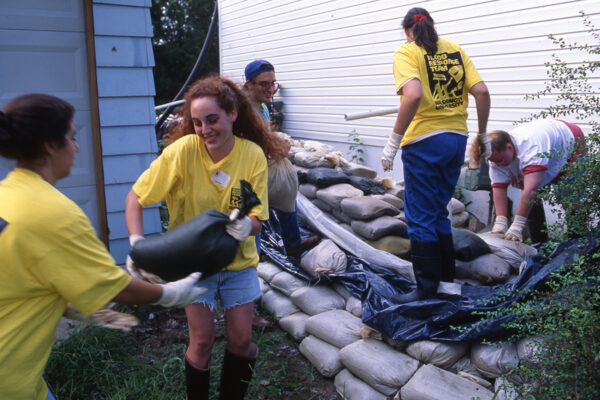Even the most extraordinary days start with ordinary moments. For example, a mom who is a groundbreaking university scientist and professor makes breakfast for her daughter before heading to the lab. A top-ranked collegiate soccer team conducts scoring drills on a historic Olympic field during an early morning practice. A young university chancellor selects a tie.
And not just any tie. It’s an extraordinary tie, for an extraordinary day.
The date is Oct. 3, 2019, and that chancellor is Andrew D. Martin. He’s wearing for the first time a tie given to him 15 months earlier by Chancellor Emeritus Mark S. Wrighton, shortly after Martin was announced as the 15th chancellor of Washington University. It’s the same tie, featuring the logo of Washington University in St. Louis, Wrighton received for his inauguration as chancellor in 1995 from then-Board of Trustees Chair William Van Cleve.
“Today is about Washington University. And it’s about momentum … where we’ve been, where we are and where we’re heading.”
— Chancellor Andrew D. Martin
Later in the day, Martin will be wearing the tie — a symbol of the change in leadership — with his academic robe as he accepts the Chancellor’s Medallion from Board of Trustees Chair Andrew Newman. He’ll be wearing it when he accepts the university charter from Newman, Wrighton and Chancellor Emeritus William H. Danforth. And he’ll be wearing it when he delivers an inaugural address that will captivate and inspire faculty, staff, students, alumni, friends and delegates from more than 80 universities with its vision, its timeliness and its candor.
“Today is about Washington University,” he will tell the gathering in Brookings Quadrangle and those watching online. “And it’s about momentum.” Momentum, Martin will say, perfectly describes “where we’ve been, where we are and where we’re heading.”
A shift in the weather
But before that extraordinary moment in Brookings Quadrangle come a few other ordinary ones. Martin’s first stop is the Sumers Recreation Center, where later that evening his inaugural dinner will be held. He’s with Newman; his wife, Stephanie; and members of his staff, performing mic checks and going over tiny details of a day scheduled down to the minute. But he’s relaxed and ready, showing Stephanie congratulatory texts and nodding at staff members who are briefing him on what’s to come.
“If anything unexpected happens, we’ll just deal,” Martin says with characteristic positivity.
He’s due in the Knight Center for the start of the inaugural symposium. Instead of getting a ride on the perimeter of campus from the Washington University Police Department (WUPD), he and Stephanie opt to walk over. And why not? The day prior saw the dedication of the Danforth Campus’ east end, and it was an unseasonably hot 90 plus–degree day. Participants at the ceremony sweltered in the late-afternoon heat and humidity. But not today. A brisk wind brought in a cold front in the early morning hours, and now it’s a delightfully pleasant 75 degrees. In the course of a few hours, summer has become fall. Even the weather has altered its momentum on this inauguration day.
As the entourage walks toward the Knight Center, past the tennis courts and the frat houses, the Martins smile at students scurrying past them. It might be his day, but classes are still in session — and there’s an academic symposium that must get under way.
‘Truly his vision’
“It’s important that this day not be all about me,” Martin says in his first official appearance of the day in Emerson Auditorium. “Today should be just as much about you.”
That he has chosen to start the day with a showcase of research and scholarship speaks volumes, as will the notable faculty members who will line up to get photographed with him before the symposium begins. It’s a lot to pack in one morning, but it’s important to Martin that the work of the university be highlighted before any hoopla.
Martin is introduced by his mentor, Lee Epstein, the Ethan A.H. Shepley Distinguished University Professor. Epstein was his faculty adviser in the mid-1990s when he first came to WashU as a PhD candidate in the Department of Political Science in Arts & Sciences. Over the past year, she served as co-chair of the subcommittee that planned the inauguration festivities, and today she is emceeing the morning event.
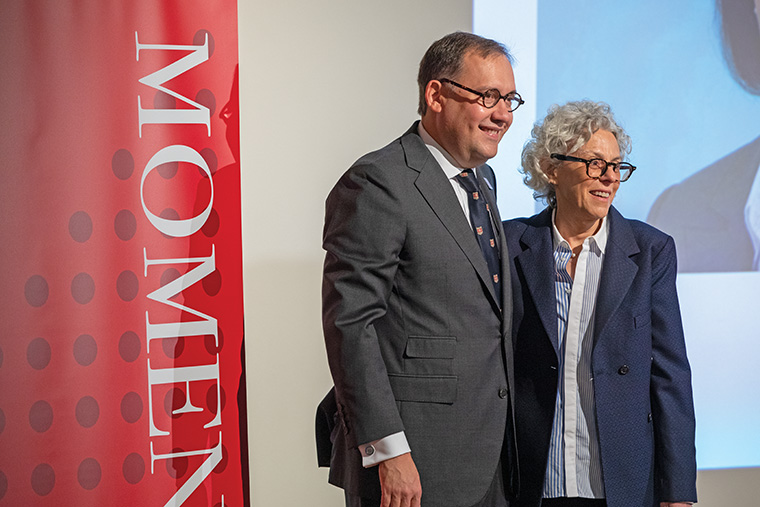
“This symposium is truly his vision, and it represents the enormous accomplishments of the Washington University community,” Epstein says.
Over the course of the next two-plus hours, 13 faculty members give short presentations on their research and the ways it contributes to the university’s momentum and to society. Among them is Hong Chen, assistant professor of biomedical engineering in the McKelvey School of Engineering and of radiation oncology at the School of Medicine.
Chen’s groundbreaking research centers on focused ultrasound, a new method of penetrating the blood-brain barrier that can both diagnose brain tumors and deliver drugs directly to them. She calls it a two-way transfer.
“The blood-brain barrier is our brain’s first line of defense,” Chen says, “but it also prevents more than 98 percent of the available drugs from reaching the brain. We use focused ultrasound to open these gates in a controlled way, so drugs can pass through the barrier.”
Chen spends mornings in her lab at the School of Medicine before driving through Forest Park every afternoon to teach classes in the McKelvey School of Engineering on the Danforth Campus. She’s in essence a human two-way transfer, momentum personified.
Making connections
As the symposium is wrapping up, Martin finally gets that ride with WUPD. He first picks up his 11-year-old daughter, Olive, who’s been doing a bit of practicing on her own for later in the day. Then father and daughter head to the Medical Campus where he’s scheduled for a meet-and-greet hosted by Dean David Perlmutter, MD.
Unbeknownst to Martin, hundreds of School of Medicine employees are waiting on the sidewalk outside the Eric P. Newman Education Center (EPNEC), waving welcome signs, holding cutouts of his face and cheering as he exits the car. It’s rock-star treatment, and he is both surprised and gracious. He works the crowd with smiles and handshakes, posing for selfies with anyone who asks. The med school team has nailed every detail, including gifts for Olive: a teddy bear wearing surgical scrubs and a T-shirt that says, “My dad’s kind of a big deal.”
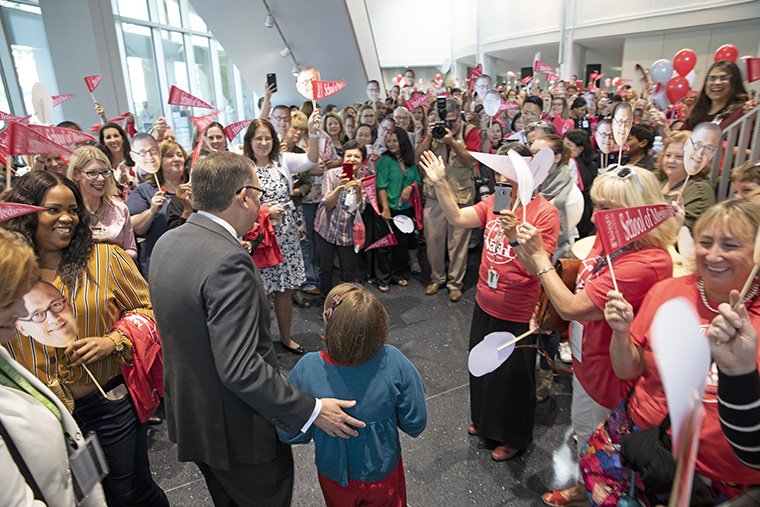
“Wow,” Martin tells the packed house in the EPNEC before he settles into an easy chair onstage to have a conversation with Perlmutter. “We’ve been blown away by the reception as we’ve come home to the WashU community.” Then he shares a derivative of the perspective he repeats throughout the day: “This is not about me. It’s about the work — your work that is transformative and life-changing,” he says.
Martin and Perlmutter talk about a wide range of topics: his love of math, his method of problem solving, and the qualities he thinks a good leader should have: “authenticity, transparency, modeling of good behavior — getting to know your team.
“One of my strengths, I believe, is the ability to make connections,” Martin says. He certainly has connected with those on the Medical Campus, and it was mutual.
History under the canopy
After the Q&A, Martin and Olive head back to the Danforth Campus for a relaxed lunch in Anheuser-Busch Hall’s Crowder Courtyard, with family, friends and delegates who have come from all over the world to wish Martin well.
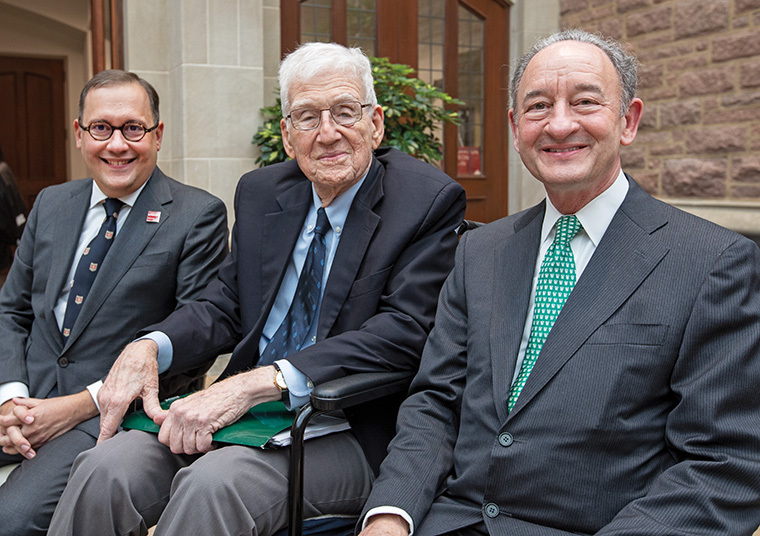
As the lunch ends, Martin, Wrighton and Danforth — more than a half-century of Washington University leadership — gather together for a photograph in a “Rushmorian” pose. It’s a special moment for Martin, and later he will mention that his dissertation is signed by both Wrighton, who was chancellor in 1998 when Martin earned his doctorate, and Danforth, who was then-chairman of the board.
‘He’s destined for great things here’
It’s about 45 minutes until the installation ceremony is set to begin, and Brookings Quadrangle is coming to life. In the center of the Quad on a raised platform stage sit Vice Provost Adrienne D. Davis, the William M. Van Cleve Professor of Law and founding director of the new Center for the Study of Race, Ethnicity & Equity; and Todd Decker, the Paul Tietjens Professor of Music and chair of the Department of Music in Arts & Sciences.
Davis and Decker are anchoring a “pregame”-style online broadcast with guests, including former Board of Trustee Chair Craig Schnuck, who led the chancellor’s search committee; Stephanie and Olive Martin, who share their version of the special day they got the call that would change their lives; and other key Washington University stakeholders. Davis and Decker are like a WashU version of Robin Roberts and George Stephanopoulos, deftly handling guests and wardrobe changes like pros.
At stage left, historic Holmes Lounge is also a beehive of activity with ceremony participants — staff, faculty, delegates and trustees — donning academic robes and adjusting tams. Momentum is building. It all looks and feels very much like Commencement, but it’s October.
Making her way through the Quad is Martin’s close friend and former classmate Christina Wolbrecht, professor of political science at the University of Notre Dame. She earned both her master’s and doctoral degrees at WashU where she met Martin. On this day, she is happy to simply play the role of his friend who will help keep him grounded. “To me, he’s just Andrew,” says Wolbrecht, MA ’94, PhD ’97, “but I know he’s destined for great things here because I know how he thinks.
“When I first knew him, he was already a leader,” she says, recalling their days as political science grad students in long-gone, utilitarian Eliot Hall. “We would all be debating what to do or where to go, but Andrew would be the one to say, ‘we’re going to do “x,” and then we’re off to the Cardinals game’ or whatever it might be.”
Wolbrecht says Martin’s energy then — and now — is contagious. “Running a university is a complicated puzzle, but Andrew will ask the right questions,” she says. “The answers won’t always be obvious and will involve a bit of experimentation, but that’s how Andrew thinks about things. He will figure it out.”
‘Right where we are’
The installation ceremony is everything it’s advertised to be: long on tradition — with its academic robes, its medallion and charter — and chock-full of vigor and optimism — with its giant video screens, its hashtags and speeches. It includes welcomes from Newman and from faculty, students, alumni and staff, including Wes Brooks, a former Gloria W. White Distinguished Service Award winner, who says, “What I love about this university … is that it stands for inclusion, it stands for diversity, but most of all, it stands for the people.”
In a moment that brings the crowd to its feet, Paul Tran, a Chancellor’s Graduate Fellow in writing in Arts & Sciences, delivers a poem they wrote on the theme of momentum.
Martin then addresses the crowd, outlining his priorities, challenging the university community, inspiring action. In his speech, he commits to building on the scholarship and research that made the university an international leader.
He vows to build a bridge to the St. Louis region, being Washington University not only in St. Louis, but “for St. Louis.” And he boldly backs it up with the “WashU Pledge,” which will provide a free undergraduate education to admitted full-time Missouri and Southern Illinois students who are Pell Grant–eligible or from families with annual incomes of $75,000 or less.
Martin makes these promises at a time when higher education is facing its biggest public challenges: “While the national perception wanes, we must turn those challenges not into threats, but into opportunities.”
Listening to it all is Stephanie Kurtzman, who has spent 21 years at Washington University in various roles in community service and engagement, including her current role as the Peter G. Sortino Director of the nationally recognized Gephardt Institute for Civic and Community Engagement.
“When we look at this speech in the history books, it will be a speech that very much reflects the world — and the nation — of 2019,” Kurtzman says. “This was the speech the chancellor needed to give. It was about this moment in time.
“One of the most powerful lines to me was when he said he wanted to eradicate the perception that St. Louis was WashU’s ‘side gig’ — ‘In St. Louis. For St. Louis,’” she says. “That single line elevated the Gephardt Institute’s work to a larger platform.
“St. Louis is where our students are, where our faculty and staff are,” she continues. “It doesn’t take away from the great work that goes on and should go on at national and global levels. But he was talking about where we live and where we have the opportunity to stitch learning and engagement together right where we are, for the betterment of the St. Louis region.”
‘Time to get to work’
The ceremony ends with the singing of the alma mater and bagpipers leading the academic procession out onto the lawn in front of Olin Library, where food booths and water stations greet the assemblage. An appearance by the Stanley Cup, won by the hometown St. Louis Blues in June 2019, surprises not only the students but Martin, too, who can’t stop smiling at the 127-year-old piece of hardware, the oldest and most venerable trophy in sports. For the WashU community, it’s time to celebrate.
Yet some students will have to wait a few hours to join in. The junior cohort of Gephardt Civic Scholars, for example, needs to attend its weekly class to prep for the biannual four-day immersion trip. Serendipitously, this year’s trip is slated to be in St. Louis — a commitment made before Martin’s speech was written, but one that dovetails completely with his vision. In particular, students will examine the St. Louis community through several lenses: economic development, public safety and public-private partnerships.
Not to worry about the Civic Scholars, they’ll have plenty of time to celebrate the historic day after their class ends. In fact, student festivities on Mudd Field go on late into the evening.
Martin’s family, friends and others in the university community continue on to dinner in the rec center, where Olive steals the show with a snappy five-minute introduction that offers a glimpse into her family’s life. She charms the audience with endearing nuggets: she likes to golf with her dad; she’s got a dog named Danny; and her mom makes her listen to “old stuff” like 1970s and ’80s music.
Later in the evening, Martin rejoins students back on Mudd Field for a fireworks display. From the band stage, he watches the extravaganza as well as the students enjoying the show. And he appreciates the moment: It’s officially time to build on the institution’s momentum, to spark his vision for the university. As he told medical faculty and staff earlier in the day, “I’ve been listening for 18 months. Now it’s time to get to work.”
